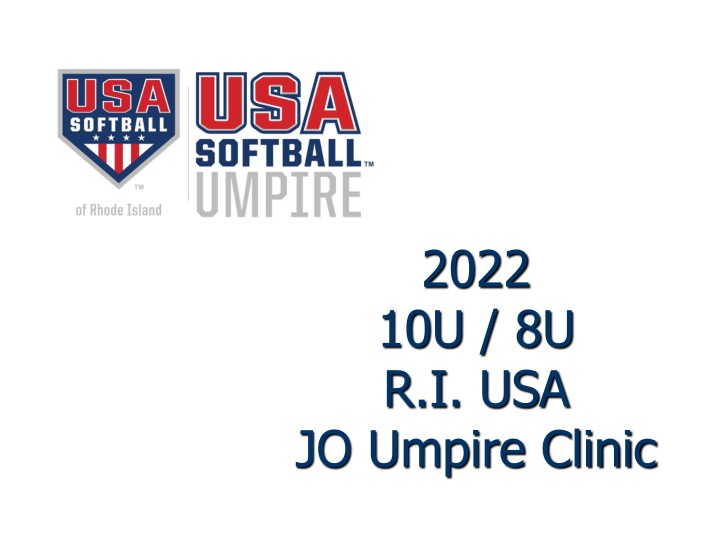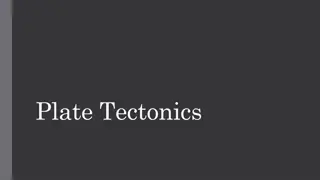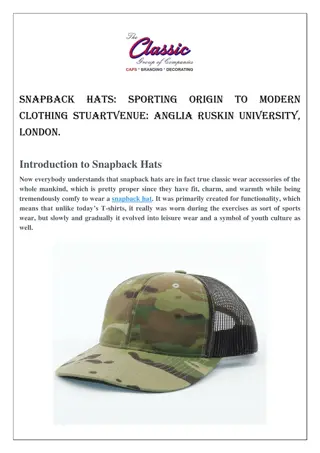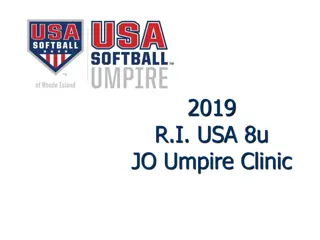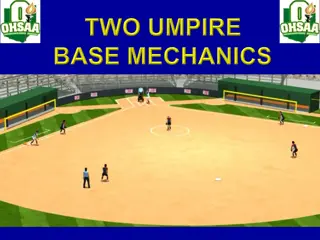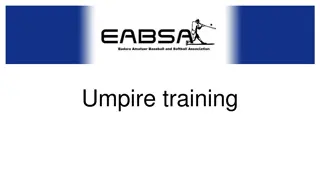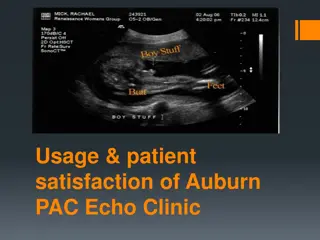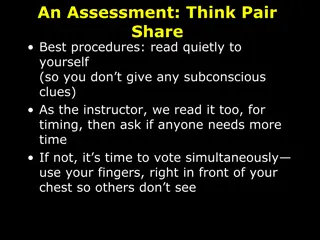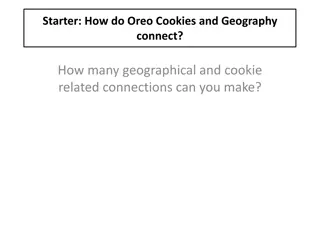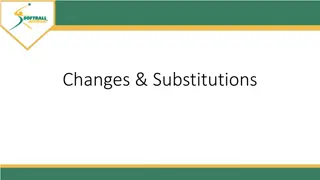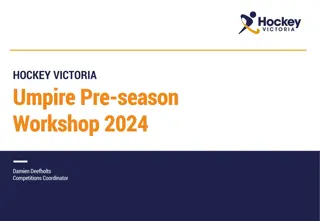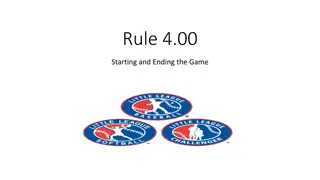Umpire Clinic Essentials: What to Wear, Game Time Tips, and Plate Mechanics
Learn key takeaways from a baseball umpire clinic, including guidelines on attire, preparation, game time procedures, plate mechanics, and dealing with coaches and fans. Discover the importance of appearance, proper equipment, and essential plate umpire movements for different game scenarios.
Download Presentation

Please find below an Image/Link to download the presentation.
The content on the website is provided AS IS for your information and personal use only. It may not be sold, licensed, or shared on other websites without obtaining consent from the author.If you encounter any issues during the download, it is possible that the publisher has removed the file from their server.
You are allowed to download the files provided on this website for personal or commercial use, subject to the condition that they are used lawfully. All files are the property of their respective owners.
The content on the website is provided AS IS for your information and personal use only. It may not be sold, licensed, or shared on other websites without obtaining consent from the author.
E N D
Presentation Transcript
2022 10U / 8U R.I. USA JO Umpire Clinic
Takeaways What to wear how to prepare Game Time Plate Mechanics 4 Elements of the game Base mechanics One Umpire System Two Umpire System USA Signals Dealing with coaches and fans 8u Rules
What to wear how to prepare Appearance is EVERYTHING Uniform Ball Bag, Belt, Shoes, Indicator, Plate Brush Protective Equipment 8U Face Mask suggested not required 10U Required Face Mask, Chest Protector, Shin Guards Rule Book (Online) House Rules
Game Time! When You Arrive at the Field: Try to arrive 15 min. early. Examine the Playing Field. Check teams equipment. Pre-Game Conference at Home Plate. Ground Rules
10U Plate Mechanics Elements of Plate Mechanics The Stance Set Position The Pitch Movement Behind the Plate When the game starts
10U The Stance Heel Toe Feet Sequencing Toe Placement Recommended Width of Feet Distance from Catcher Head Rotation Catcher Head to Pitcher Shoulders at Plate Bend at Knees
10U Set Position Start in Slot Behind Catcher Inside the Plate Outside the Strike Zone Good Pelvic Alignment Outside front corner of the Plate Through the Strike Zone Hands in front of Body When to Set Start of the Pitch Fast Pitch / Slow Pitch
10U The Pitch Stance and Set Position come into play Tracking the ball Slight head movement guided by Nose with Eyes in Locked Position Good Timing when making the call Down position Verbal Strike and Upright Signal Verbal only for Ball Foul Tip Delay Dead Ball Obstruction or Illegal Pitch
10U Movement A good Plate Umpire realizes that they are not only required to call balls and strikes, but must be able to move to cover other responsibilities The Plate Umpire must be ready and able to move during the game Umpire movement is based on reading the shoulders of the catcher. Plate Umpire should always exit to the left of the catcher
Behind the Plate Prepare for the pitch. Calling the pitch. Strike. Ball. Keeping the Count. Timing. Fair and Foul Balls
When the play starts, Keep these in mind: How many outs are there. What the count is. How many runners are on base. Game situation. Score of the game. How are the fielders set up.
4 Elements of the game Always keep all four elements in front of you. Ball Base Offense Defense
Base Mechanics One Umpire system: Hustle. Remember the 4 elements when making the call. Get into the proper position on every play to make the call. Get out from behind the plate quickly (stay out of the players way) and move into the play to get a good view.
One Umpire Field Mechanics Ground Ball to Infield A. No runners on base. B. Runner on 1st base or 1st and 2nd C. Bases loaded.
One Umpire Field Mechanics Ball hit to the Outfield A. No runners single B. No runners double C. No runners triple D. No runners homerun
One Umpire Field Mechanics Fly Ball Situations A. No runners, not near foul line. B. Runner on 1st C. Runner on 1st and 2nd D. Runners on 2nd and 3rd or 1st and 3rd
Fair and Foul Balls Always try to straddle the line to make fair/foul calls on fly balls hit near the foul line. Always wait until the ball is touched, comes to a stop or has no chance of becoming fair from foul territory or foul from fair territory before making the call.
One Umpire System Exercise 1 No Runners on base Ground ball hit to F6
One Umpire System Exercise 2 Runners on 1st and 3rd base Ground ball hit to F4
One Umpire System Exercise 3 Runners on 2ndt Base hit on the Right field line
Base Mechanics Two Umpire system: Always communicate with your Partner. Hustle. Remember the 4 elements when making the call. Get into the proper position on every play to make the call.
READY POSITION 18-21 FEET BEYOND 1B WALK THE LINE FAST PITCH FAST PITCH NO RUNNERS ON
STARTING POSITION RUNNER ON 1B FAST PITCH FAST PITCH DOUBLE PLAY
READY POSITION 18-21 FEET BEYOND 1B BUTTONHOOK FOLLOW THE RUNNER NO RUNNERS ON DOUBLE FAST PITCH FAST PITCH
BUTTONHOOK FOLLOW THE RUNNER RUNNER ON 1B BASE HIT FAST PITCH FAST PITCH FAST PITCH FAST PITCH
MOVE TO GET 90 VIEW OF THE TAG RUNNER ON 1B PICKOFF AT 1B FAST PITCH FAST PITCH FAST PITCH FAST PITCH
MOVE TO GET 90 VIEW OF THE TAG RUNNER ON 1B STEALS 2B FAST PITCH FAST PITCH FAST PITCH FAST PITCH
STARTING POSITION FAST PITCH FAST PITCH FAST PITCH FAST PITCH RUNNER ON 2B
MOVE TO GET 90 VIEW OF THE TAG RUNNER ON 2B PICKOFF AT 2B FAST PITCH FAST PITCH FAST PITCH FAST PITCH
STARTING POSITION RUNNER ON 1B & 2B FAST PITCH FAST PITCH
STARTING POSITION RUNNER ON 1B & 2B FAST PITCH FAST PITCH
MOVE TO GET THE BEST ANGLE AND DISTANCE POSSIBLE RUNNER ON 1B & 2B PICKOFF AT 1B FAST PITCH FAST PITCH
STARTING POSITION FAST PITCH FAST PITCH BASES LOADED
STARTING POSITION FAST PITCH FAST PITCH BASES LOADED
STARTING POSITION BASES LOADED PICKOFF AT 3B FAST PITCH FAST PITCH
STARTING POSITION BASES LOADED PICKOFF AT 3B FAST PITCH FAST PITCH
Two Umpire Field Mechanics Ground Ball to Infield A. No runners on base. B. Runner on 1st base C. Runners on 1st and 2nd D. Runners on 1st and 3rd 2nd and 3rd , or bases loaded E. Bases loaded.
Two Umpire Field Mechanics Ball hit to the Outfield A. No runners single B. No runners double C. No runners triple D. No runners homerun
Two Umpire Field Mechanics Fly Ball Situations A. No runners, not near foul line. B. Runner on 1st C. Runner on 1st and 2nd D. Runners on 2nd and 3rd or 1st and 3rd
Fair and Foul Balls Plate umpire makes the call. Always try to straddle the line to make fair/foul calls on fly balls hit near the foul line. Always wait until the ball is touched, comes to a stop or has no chance of becoming fair from foul territory or foul from fair territory before making the call.
Two Umpire System Exercise 1 No Runners on base Ground ball hit to F6
Two Umpire System Exercise 2 Runners on 1st and 2nd base Ground ball hit to F4
Two Umpire System Exercise 3 Runners on 2ndt Base hit on the Right field line
USA signals cont.
Dealing with coaches and fans You are in charge of the game! At ground rules Make sure the head coach understand he is the only one to come to you with questions. Always be approachable, listen to the question, then explain your call and end the conversation. Make sure the coach understands he is responsible for his fans. If you have a problem and all else fails GET A BOARD MEMBER IN CHARGE. DO NOT CONTINUE THE GAME!!
Coach Pitch/8U Division Rules A coach of the team that is batting will pitch. 1. Each batter will be pitched a maximum of 6 pitches. If still at the plate after the 6th pitch has been thrown, the batter will be declared out. Balls and strikes are not called, only the amount of pitches thrown will be counted. A batter can strike out swinging.
2. A safely hit ball to the infield will allow both the batter and all base runners to advance one base with the liability of being put out. 3. A safely hit ball to the outfield, whether in the air, on the ground, or after being touched by a defensive player (ball must reach the outfield grass) allows both the batter and all base runners to advance 2 bases with the liability of being put out.
4. A chalk line will be installed in the outfield, 125 ft from home plate. If a ball is hit past this line in the air, on the ground, or after being touched by a defensive player, the batter and all base runners will be allowed to advance as many bases as they want to with the liability of being put out. At fields with fences of 125 feet or less, any ball hit off the fence will have the same effect. A ball that bounces over the fence will be a ground rule double.
